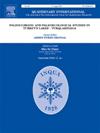Chronological sequencing, site selection, and environmental context of Neolithic island settlements in southeastern coastal China
IF 1.8
3区 地球科学
Q3 GEOGRAPHY, PHYSICAL
引用次数: 0
Abstract
Prehistoric island-type sites in coastal areas are highly influenced by marine hydrological changes due to their unique geographical settings. Haitan Island in South China is a key area for understanding the origins and dispersal of Austronesian civilization. Recent archaeological investigations have uncovered key Neolithic sites on the island, yielding a material record that offers a unique opportunity to address these questions. However, addressing the gaps in the absolute chronology of these sites and unraveling the dynamic processes of human-environmental evolution remain urgent research priorities. This study used Thermoluminescence (TL) and Optically Stimulated Luminescence (OSL) dating techniques to analyze pottery from Neolithic sites on Haitan Island, southeastern China, to establish a reliable chronology. Dating results (radiocarbon and pottery OSL) indicate that the Xiying, Jianhu, and Citanghoushan sites on Haitan Island date to the mid-Holocene (7.5–6.5 ka). These findings extend the temporal range of the Keqiutou culture (6.5–5.5 ka) in the Minjiang River lower reaches, highlighting its significance in regional archaeology. Comparing the chronology of Haitan Island sites with Holocene sea-level changes at the Minjiang River mouth reveals that ancient human activity was primarily concentrated there during the high sea-level stage from 7 to 6 ka. The terrace where the Keqiutou site group is currently situated provided an optimal habitat for ancient humans, offering shelter and abundant food resources essential for survival.
中国东南沿海新石器时代岛屿聚落的时间顺序、地点选择和环境背景
沿海地区的史前岛屿遗址由于其独特的地理环境,受到海洋水文变化的高度影响。中国南方的海滩岛是了解南岛文明起源和传播的关键地区。最近的考古调查发现了岛上关键的新石器时代遗址,提供了一个独特的机会来解决这些问题。然而,解决这些遗址的绝对年代学差距和揭示人类-环境进化的动态过程仍然是迫切的研究重点。本研究利用热释光(TL)和光激发发光(OSL)测年技术对中国东南海滩岛新石器时代遗址的陶器进行了分析,以建立可靠的年代。放射性碳测年和陶器OSL测年结果表明,海滩岛西营、剑湖和赤塘后山遗址的年代为全新世中期(7.5 ~ 6.5 ka)。这些发现扩大了岷江下游克丘头文化的时间范围(6.5 ~ 5.5 ka),突出了其区域考古意义。将海滩岛遗址的年代学与岷江河口全新世海平面变化进行对比,发现古人类活动主要集中在7 ~ 6 ka的高海平面阶段。柯丘头遗址群目前所在的梯田为古代人类提供了最佳栖息地,为生存提供了住所和丰富的食物资源。
本文章由计算机程序翻译,如有差异,请以英文原文为准。
求助全文
约1分钟内获得全文
求助全文
来源期刊

Quaternary International
地学-地球科学综合
CiteScore
5.60
自引率
4.50%
发文量
336
审稿时长
3 months
期刊介绍:
Quaternary International is the official journal of the International Union for Quaternary Research. The objectives are to publish a high quality scientific journal under the auspices of the premier Quaternary association that reflects the interdisciplinary nature of INQUA and records recent advances in Quaternary science that appeal to a wide audience.
This series will encompass all the full spectrum of the physical and natural sciences that are commonly employed in solving Quaternary problems. The policy is to publish peer refereed collected research papers from symposia, workshops and meetings sponsored by INQUA. In addition, other organizations may request publication of their collected works pertaining to the Quaternary.
 求助内容:
求助内容: 应助结果提醒方式:
应助结果提醒方式:


